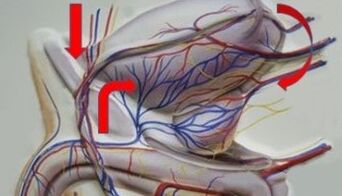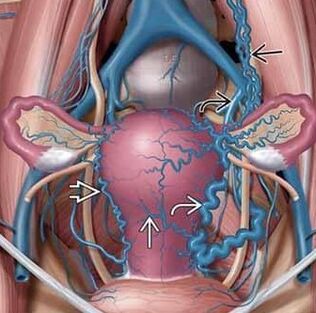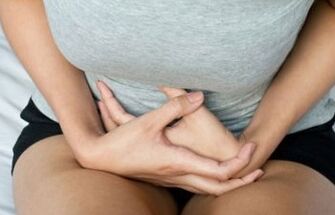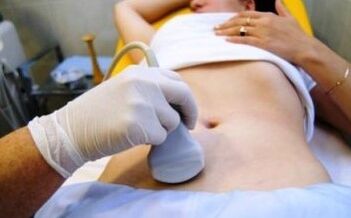Varicocele in the pelvis (WRMW) or chronic pelvic pain syndrome remains an exotic disease, and for many doctors, the diagnostic boundary is fuzzy in the diagnostic community.
This explains the fact that some doctors "did not notice" the disease of this patient for a long time, while others diagnosed the diagnosis as nearly every second person suffering from an inexplicable pain in the lower abdomen.

At the same time, the patient's further quality of life, his ability to enjoy intimate relationships with relatives and his ability to continue his family depends largely on the timely discovery of varicose veins, which depends largely on.
Disease description, prevalence, statistics
For a long time, doctors have known about chronic pelvic pain. But, until recently, it has become the most well-known and most likely cause of varicose veins in the pelvic region. This is a diseaseIt was first described in 1975And the research is not very good.
This pathology is likely to develop according to the following algorithm:
- The venous plexus in the pelvis is a complex formation that includes a large blood vessel trunk and smaller veins extending from it. Meanwhile, the venous systems of small and medium pelvis in both male and female are different in their structure, which determines the gender specifications of the disease - VRVMTThis is more common among weaker gender representations.
- As the vessel is squeezed, the intact or partial blockage of the venous passageway, the change in tone of the blood vessel wall is disturbed by the outflow of blood from the deep bone veins.
- As a result, the vein no longer fully performs its function:Inadequate progression of venous valvesNormal blood flow is disturbed.
- In the pelvic vein, stagnation associated with reverse blood administered through the blood vessel begins - which causes veins to swell and the development of varicose veins.

Venous veins of internal organ veins of the pelvic organs (varicose veins) are more common in reproductive age women than men. Meanwhile, in 85% of cases, ovarian veins ("ovary") veins are most commonly experienced.
The main symptoms are pain recorded in more than 90% of patients. However, the prevalence of the disease in the population has not been clarified: according to different studies, it is between 6% and 80%. In "testimonials", such a large run is explained only by the lack of qualifications of the doctor at the time of diagnosis.
Causes and risk factors
The cause of pelvic varicose veins is that any change in the human body can cause the emission of the pathological mechanisms of the disease:
| Anatomical and physiological causes of varicose veins | What can cause this |
| Mechanical compression of pelvic veins |
|
| Change the tone of blood vessels |
|
| Clogged pelvic pulse |
|
The high risk factor VRVMT is:
- Tensional physical labor;
- Sex life that is insufficient or unsatisfied;
- life through abusive intimacy in interrupted sexual intercourse;
- massive pregnancy and childbirth;
- Frequent gynecological diseases;
- Contraception with hormone drugs;
- Hormone failure in the body;
- Hypoemia.
Classification and stage of varicose veins
In a medical setting, conditional separation of VRVMT is accepted by the nature of the course with varicose veins and external genitals (such as labia) and vein-like syndrome.
This classification doesn't have much practical significance, becauseIn most cases, patients have both formsAt the same time, it's like provoking each other.
You can also find the classification of the disease by its root cause. In this regard, VRVMT is divided into:
- Basic- Caused by unsatisfactory work of the venous valve;
- Secondary- Complications of existing inflammation, gynecological or oncological diseases that develop into internal organs.

What is dangerous and whether there will be consequences
This type of vascular pathologyCan't be called a fatal disease. Over time, it is perfect for medical corrections. But the whole problem is finding it is not that simple. Inadequate understanding of the disease and low awareness of most diagnostic doctors play a role in it.
Therefore, it turns out that the patient has been suffering from the disease for many years without even doubt. at the same timeThere are many irreversible changes:
- Variants progress, adjacent areas include during pathological processes - swelling of the genital veins (e. g. , varicose veins of the penis), the appearance of the vagina and lower limbs.
- There are persistent dysfunctions of internal reproductive organs, which isMay cause infertility or intolerable pregnancyAmong women.
- In the context of pain syndrome, various psychological and emotional disorders have been developed through the types of neurasthenia.
- Due to chronic pain and intimacy, a person may give up on sexual behavior altogether.
- The rarest and most severe pelvic varicose complications are considered vein thrombosis and pulmonary thromboembolic. themMeet in about 5% of cases, but always fatal.
diagnosis
According to U. S. researchers, in the early 2000s, only 2% of patients with VRVMT initially made the correct diagnosis. Sometimes the result of a false diagnosis is to remove the detergent organ from a woman, although if used, such organs can be avoided.The most accurate way to diagnose pelvic varicose veins:
- Study on ultrasound and doprasses of veins- Varicocele can be suspected;
- Intravenous- Invasive studies, which allow for high accuracy to determine the presence and extent of the disease;
- laparacopy- If the diagnosis is differentially diagnosed as VRVMT, it is diagnosed by differential symptoms of gynecological disease (endometriosis, fibroids, colitis).
- Selective ovarian map- Research on venous state by introducing contrast problems is considered the most objective diagnostic method.
- Computer or magnetic resonance imagingIt allows you to shed light on the details of the disease and distinguish it from other non-toxic pathology (joint disease, Crohn's disease, etc. ).

Predictions and preventive measures
Without surgical intervention, it is almost impossible to completely cure varicose veins in the small pelvis. With the help of conservative medicineYou can greatly promote and even eliminate most unpleasant symptomsand significantly reduce the risk of disease complications. The surgery does not guarantee that the disease will not recover.
To prevent recurrence of the diseaseIt is always necessary to adhere to the "antivariate" lifestyle:
- Smoking is prohibited;
- Do not use hormone drugs uncontrollably;
- Move more, stand on your feet motionlessly;
- Observe a protein-resistant diet in large quantities of fresh plant foods;
- Perform a series of therapeutic gymnastics and respiratory exercises every day to maintain blood vessel health;
- After surgery for VRVMT, it is necessary to wear compressed knitted clothing and take the preventive dose of drug prescribed by the doctor.
Pelvic varicose veins -This is a hidden disaster for women's health, a kind of ghost disease, it's hard to find, but suffering from it is very real.
The main symptom of the disease is a chronic pelvic pain that can torture patients for a long time and become a source of giving up many of the pleasures of life. You can't stand this discomfort and you can't see a doctor!
When specific symptoms appear, you need to know clearly that it is abnormal and seek help from an expert right away.

Basic Therapy
In the treatment of varicose veins in the pelvis, the basis includes the correction of its nutrition. First, women with VRVMT should be informed that even if Detralex does not refuse to work in harmful production, even they will not be properly efficient.
If there is such an opportunity, it is best to switch to a lighter job - not including excessive physical exercise, weightlifting.
If you have to sit or stand for a long time during the weekdays, arrange your own 5-minute break every half hour. Currently, you can walk or lie down or perform therapeutic gymnastics.
There is no dietary change, and high-quality treatment of varicose veins cannot be done. From the diet, it is necessary to completely remove fat and fried foods, smoked foods and protect. Use as few citrus fruits as possible and try to use less seasoning when cooking.
Add more natural products – fruits and vegetables to your daily menu. Instead of animal fat, use plant fats – they contain a lot of B vitamins.
As the pain in the pelvic vein swells, it is necessary to wear special compressed flax. We are talking about sweaters or stockings, which help normalize blood circulation in the blood vessels and eliminate fluid stagnation in the veins.
In addition to all of the above, women with VRVMT should engage in anti-disease methods every day. It includes the following exercises:
- Swim in the pool or expose the pond with clean water;
- Jogging in the morning;
- Bicycle skiing;
- Cycling or skating.
A daily shower will help adjust the veins. Water over the area of hips, abdomen and buttocks with jets of different temperatures.
Drug Therapy
If the disease of the pelvic vein is in the initial stages of development, you can try to deal with it with the help of medication. The degree of damage can be detected by ultrasound (ultrasound examination of the pelvic vein).
Varicocele in the pelvis during pregnancy is often found. If a woman will give birth soon, it is necessary to stabilize her condition as soon as possible.
Preventive measures
It is almost unrealistic to get rid of varicose veins in the pelvic body without resorting to surgical intervention. However, the boat never expands on its own, which means the hassle can be avoided by adjusting the lifestyle.
Even after surgical intervention, you cannot guarantee that the disease will not recover again. Of course, modern conservative approaches greatly simplify the treatment and recovery process. Recurrence can only be avoided by following many rules:
- Refuse to smoke;
- The cause of pelvic varicose veins in women is usually the use of incorrectly selected hormone contraceptives.
- Try to stay active and rest regularly;
- Observe small pelvises with small diets - Eat natural foods of many plant origins;
- Maintain the tone, perform pelvic varicose veins treatment exercises, and set up respiratory gymnastics;
- Follow all doctors’ prescriptions during the recovery period after surgical intervention – wear compressed underwear and take medication promptly.

Folk therapy
To relieve symptoms and speed up the recovery of affected veins, traditional medical methods are used. However, do not use natural medicines without consistency with your doctor.
List of effective recipes:
- Pour the teeth (4 tablespoons) and lemon zest into boiling water (1 L). After cooling, add honey to the infusion (2-3 tablespoons L. ). Drinks are for use rather than tea.
- The maxi (200 g) was crushed and poured in with vodka (1 L). The tool is injected into dark places for 7 days. Recommended dosage: 10 times a day 3-4 times a month.
- Pour the oak, willow and chestnut branches into the pot in crushed form (1 tablespoon), pour into the pot with boiling water (1 liter) and place on low heat. After boiling for half an hour, remove the soup from the stove and cool. Next, add chamomile, series, dry and St. John's wort (1 tablespoon). The deadline is 12 hours. A small amount of honey should be placed on filtered medication.
Decoction regimen: 50 ml in the first 2 days, -3 times 2 times, and the next 2 days -100 mL, in the future, increase the dose to 150 mL. The duration of treatment was 20 days, followed by 10 days of rest.
To improve blood vessel conditions, it is useful to use blueberries and pollen every day.
When using folk remedies, it is important to understand that they only supplement the main course and therefore do not want to reject medications prescribed by the doctor.
A regular physical examination is not important, which will allow you to detect any deviations in time and continue treatment. The earlier the disease is detected, the easier it is to deal with it. Severe cases require prolonged treatment.
Varicocele lesions in the pelvic vein can be eliminated by conservative methods. They fight neglected diseases with the help of surgery, and pathology can occur repeatedly even after surgical manipulation.
Thanks to prevention, this will potentially minimize the risk of VRVMT, which means a healthy lifestyle.

















